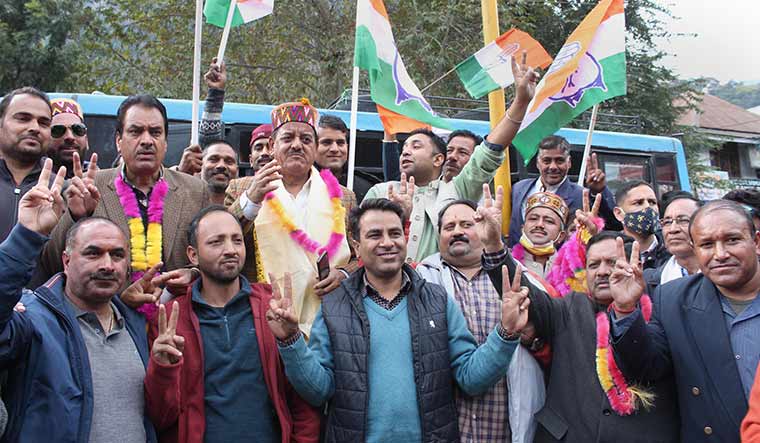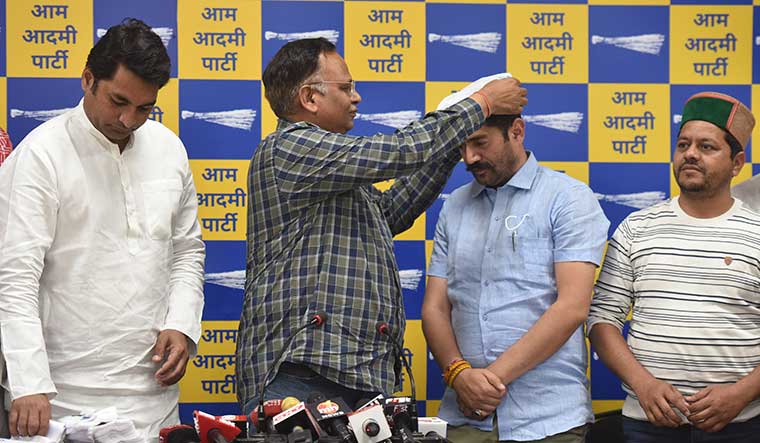TWO DAYS AFTER the Aam Aadmi Party’s massive victory in Punjab, Delhi Health Minister Satyendra Jain held a celebratory road show in Shimla. Much to the consternation of BJP and Congress supporters, Jain declared that the AAP would contest all seats in the assembly polls in Himachal Pradesh, due in October this year.
The hilly state offers the best chance for the Congress to make up for its poor show in Punjab and Uttarakhand. The BJP, for its part, will try to break the state’s three-decade-old pattern of not re-electing the ruling party. The state’s bipolar polity has alternated between Congress and BJP governments since 1990.
The 2022 elections also mark a departure from previous polls. Virbhadra Singh of the Congress and Prem Kumar Dhumal of the BJP, who had long been the state’s tallest leaders, will not have a face-off this time. Dhumal fell off the radar after losing his seat, even as the BJP won the polls in 2017. Virbhadra Singh died last year. The elections this year, therefore, has been billed as a generational change in state politics—one in which new leaders will be tested in the absence of veterans who dominated politics for four decades.
Both parties are looking for a new idiom to mark this change. The BJP, fresh off its victory in four states, hopes that Himachal will go the way of Uttarakhand, where the party made history by winning a second consecutive term. “Himachal Pradesh represents the same thought process,” said Sanjay Tandon, co-in charge of the BJP’s state unit. “We will be re-elected. The BJP has good organisation on the ground. This is our inherent advantage. Our cadres are excited after the results in four states. We are starting meetings with them in all four parliamentary constituencies here.”
BJP hopes its ’double-engine’ slogan will work its magic again, as a lot has been done on the ground in terms of delivery of Central and state government schemes and free distribution of ration during the pandemic.
Interestingly, both the BJP and the Congress have similar views of the AAP. “No third party has made any progress in the state,” Tandon said. “It has been a bipolar polity.” Sanjay Dutt, the AICC secretary in charge of the state, said: “The AAP is more hype than reality. It has no organisation structure or known face across Himachal.”
But, according to Ramesh Chauhan, professor at the department of political science, Himachal Pradesh University, the tremors from Punjab are being felt in the state. “People have started talking about the AAP. But it is yet to be seen how far will the AAP influence Himachal Pradesh. It will have some impact, as many of the state’s districts border Punjab,” he said.
Rebel candidates, who tend to contest in 40 per cent of seats, are likely to influence results. Those who are denied tickets by the BJP and the Congress will now have a choice in the AAP. Also, in the absence of veteran leaders, the generational change in both the Congress and the BJP has been mired in faction feuds.
Congress draws hope from the success it had in November last year, when the party won all seats—one Lok Sabha and three assembly constituencies—in a round of byelections. The results had signalled anti-incumbency against the Jairam Thakur government and infighting within the BJP. “These bypolls were won in the absence of Virbhadra Singh and other veteran leaders. It broke the myth that the Congress can only win with Virbhadra Singh’s help,” said Congress legislator and former state party president Sukhwinder Singh Sukhu.
Dutt said the Congress was conducting agitations to motivate its cadres. “We are not complacent; we are taking up the people’s causes,” he said. “The Congress suffered in some states as it did not focus on grassroots organisation, while the BJP had panna pramukhs monitoring voter lists. We are in the process of setting up booth committees, and involving all party units and front bodies to campaign for the elections.”
Among 50 lakh voters in the state, more than three lakh are state government employees. Employee unions have always played a key role in the elections, as the government is a major employer apart from the tourism sector. Taking a cue from the party-ruled states of Rajasthan and Chhattisgarh, which are set to replace the existing contributory pension scheme with the old pension scheme, the Congress in Himachal Pradesh, too, has promised to restore the old scheme if voted to power. In the contributory pension scheme, which the BJP government had brought in, it is the employees who contribute towards their retirement fund instead of the government.
To counter the BJP’s messaging that the cow is sacred, the Congress is working on its own narrative that, according to Sukhu, would transform the state through its focus on rural economy. “We will propose that milk be bought at Rs40 per litre, and vegetables at Rs20 per kilo. This will be the first time in the country where a minimum support price will be paid. This will generate employment and rejuvenate the rural economy, as 90 per cent of the state’s population depend on it,” said Sukhu. “This will lead to an additional cost of Rs150 crore, as the state produces three lakh litres of milk, but it will not be a strain as we will rework other subsidies.”
Hindus make up 97 per cent of the state’s population. Unlike the neighbouring Uttar Pradesh or Uttarakhand, where the BJP’s Hindu nationalism has been aggressive, Himachal Pradesh is calmer. Rajputs comprise more than 35 per cent of the population, followed by nearly 25 per cent dalits. The BJP recently chose a dalit candidate, Himachal Pradesh University vice chancellor Sikander Kumar, as its Rajya Sabha nominee.
The constituencies in upper Himachal have been Congress strongholds, while districts in lower Himachal that adjoins Punjab, such as Hamirpur, Bilaspur, Chamba and Una, veer towards the BJP. Lower Himachal has the bulk of assembly seats—46 of 68 constituencies. So, if the AAP eats into anti-incumbency votes, the Congress would be affected.
For the BJP, the 2022 elections will be a litmus test of Jairam Thakur’s leadership. He was chosen as chief minister after the BJP won the previous polls. Last year, as the party began evaluating the performance of its chief ministers, there was strong buzz that Thakur would be replaced. But he survived.
While the BJP will rely on Prime Minister Narendra Modi’s charm to see it through, the polls are also of great importance to party president J.P. Nadda, as he hails from the state.
Elections to the Shimla Municipal Corporation, due in April, will be the acid test for all stakeholders before the assembly polls. Being the capital, Shimla has people from all parts of the state, and has a large population of government employees. What happens there will indicate which way the wind is blowing. “As far as gauging the mood of the people is concerned,” said Ramesh Chauhan. “the Shimla elections will be the semi-final before the final.”




